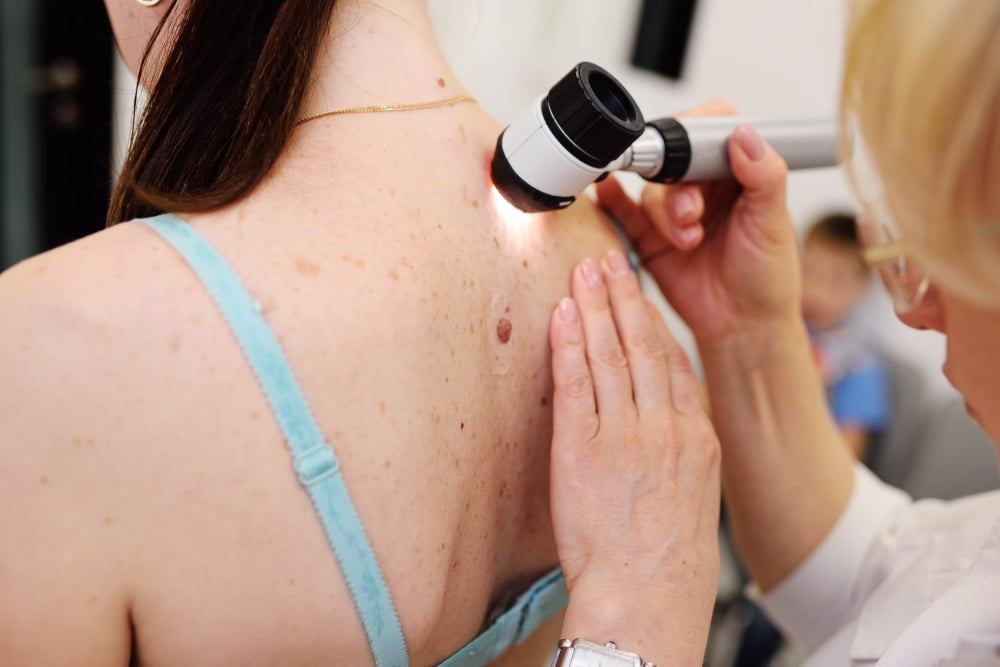Skin cancer is increasingly common in the United States. According to the Skin Cancer Foundation, one in five Americans will develop skin cancer before they turn 70. The good news is that skin cancer can be easily detected because it's one of the only cancers you can see. Frequent skin checks—both at home and by a Dermatologist—can help you catch early-stage skin cancer, and it may just save your life.
A Dermatologist explores what to look out for during skin checks, and what to do if you identify a concerning spot or mole.
The Importance of Regular Skin Checks
Beyond wearing sunscreen every day, skin checks are essential for your skin health. You know your own skin better than anyone, so with careful examinations, you have the power to stop cancer in its tracks.
You should perform regular self-skin checks at home on a monthly basis. Have a friend or significant other check your back since it can be difficult to do so yourself, or stand in front of a full-length mirror, using a handheld mirror to see those tricky spots. Take note of the color and shape of your moles so that you can keep a watchful eye on any changes that may occur.
If you find anything concerning on your skin, you should see a board-certified Dermatologist as soon as possible. They will be able to determine if it is skin cancer and, if so, what type it is by performing a skin biopsy. From there, they will develop a treatment plan.
You should visit your Dermatologist annually. If you fall into the high-risk category, it's recommended that you visit every three to 12 months. As outlined by the Centers for Disease Control and Prevention, risk factors include:
- Fair skin
- Skin that freckles or burns easily
- Blue or green eyes
- Blond or red hair
- A large number of moles
- A family or personal history of skin cancer
- Advanced age
How to Identify Skin Cancer
Skin cancer detection relies on self-examinations, but you need to know what to look out for. Any new growth on your skin that does not go away or feels tender, bleeds, or changes in any way should be evaluated by a board-certified Dermatologist.
According to the Mayo Clinic, there are three main types of skin cancer: basal cell carcinoma, squamous cell carcinoma, and melanoma. They all look and act differently—but regardless of type, the sooner they're caught, the easier they are to treat successfully.
- Basal cell carcinoma usually appears as a small, round, pearly bump on the skin. It can also look like a flat, scaly patch or a crusted sore. This is the least aggressive form of skin cancer, typically growing slowly and only rarely spreading to other parts of the body.
- Squamous cell carcinoma usually appears as a firm, red bump on the skin. It can also look like a flat, scaly patch or an open sore. This type sometimes spreads to other parts of your body but is not usually fatal.
- Melanoma is the most serious form of skin cancer and can appear as a new mole or growth on your skin, or it can develop from an existing mole or growth. It can spread to other parts of the body and can be deadly, but with early detection, it's often treatable. Melanomas are often dark in color and may have irregular borders, but they can appear in other ways, too. Keep the ABCDEs of melanoma (asymmetry, border, color, diameter, evolving) in mind as you check your skin from head to toe.
Skin Cancer Detection: What Happens Next?
If you catch skin cancer early, don't panic—because you're in a good position to beat it. In fact, among all people with melanoma, the five-year survival rate from initial diagnosis is 93 percent, according to the American Society of Clinical Oncology. Late detection can cause skin cancer to metastasize, which lowers your chances of survival.
Don't wait. If you notice anything unusual during a self-check, make an appointment to see a Dermatologist as soon as possible. They will examine your skin and take a biopsy for an accurate diagnosis. Together, you and your doctor will develop a treatment plan based on the stage and severity of the disease. In most cases, early-stage skin cancers can be treated with surgery, radiation therapy, or topical medications. If cancer has spread to other parts of your body, more aggressive treatments may be necessary.
Prevention and detection of early-stage skin cancer are key to successful treatment and recovery. When you come out on the other side of a skin cancer diagnosis, sunscreen should be your best friend. Always look for a product with an SPF of 30 or higher, like the EltaMD UV Sheer Broad-Spectrum SPF 50+, and get into the habit of wearing it every day. In the end, protecting your skin is a lifelong and rewarding journey.
